参考链接:https://blog.csdn.net/Pandafz1997/article/details/120558429
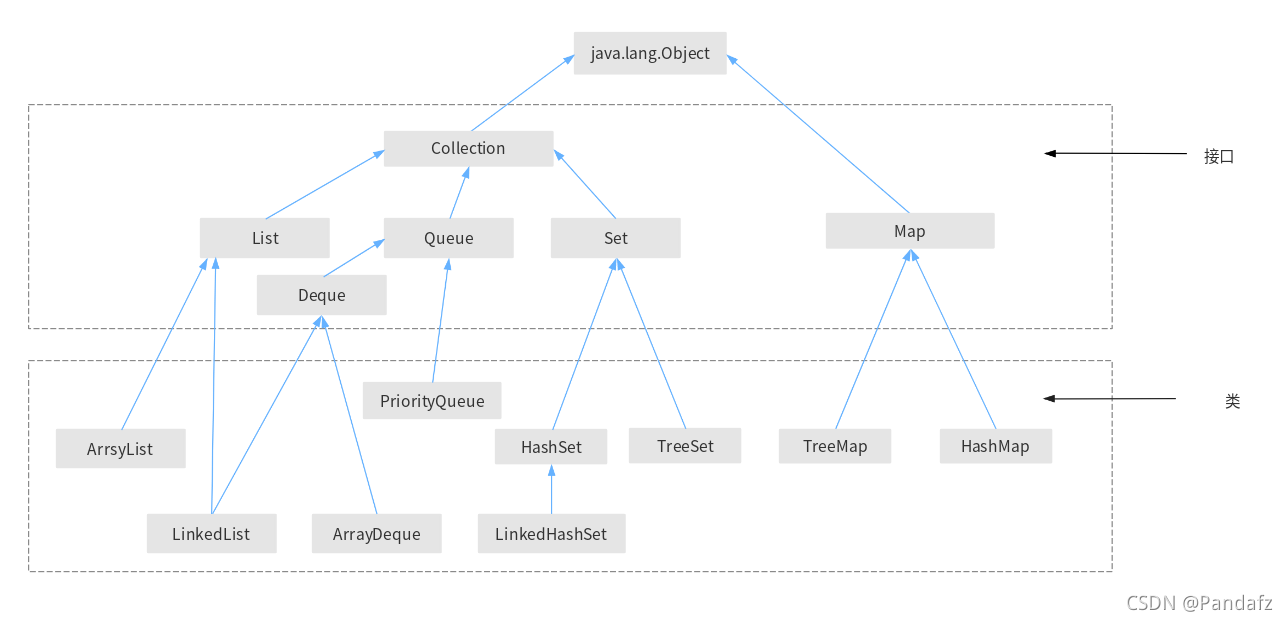
List add remove get set Iterator size Map put remove get containsKey/Value keySet() size Stack push pop/clear/isEmpty() search peek size Set add remove/clear/isEmpty() contains Iterator size que offer poll/clearList add remove get set Iterator size
Iterator接口
Iterator通过遍历(迭代访问)集合中的元素来获取或删除某元素
import java.util.*; public class RongQi { public static void main(String[] args) { ArrayList arrayList = new ArrayList(); arrayList.add("ab"); arrayList.add("cd"); arrayList.add("df"); System.out.println("集合内容如下: "); Iterator iterator = arrayList.iterator();// iterator()方法返回一个Iterator对象 while (iterator.hasNext()) { Object o = iterator.next(); System.out.println(o); if (o.equals("df")) { iterator.remove(); } } System.out.println("删除df之后 " + arrayList); } }
集合内容如下:
ab
cd
df
删除df之后 [ab, cd]
List
List中元素可以重复,并且是有序的(这里的有序指的是按照放入的顺序进行存储。如按照顺序把1,2,3存入List,那么,从List中遍历出来的顺序也是1,2,3)
List可以将元素维持在特定序列中,常见的子类实现有
ArrayList 快速查询,插入删除效率低
ArrayList底层是用数组实现的,可以认为ArrayList是一个可改变大小的数组。随着越来越多的元素被添加到ArrayList中,其规模是动态增加的。
LinkedList 快速插入删除、查询效率低
LinkedList底层是通过双向链表实现的 更占内存 为每个节点存储2个引用 分别指向前一个元素和后一个元素
ArrayList、 LinkedList 和 Vector都实现了List接口,是List的三种实现
List 方法
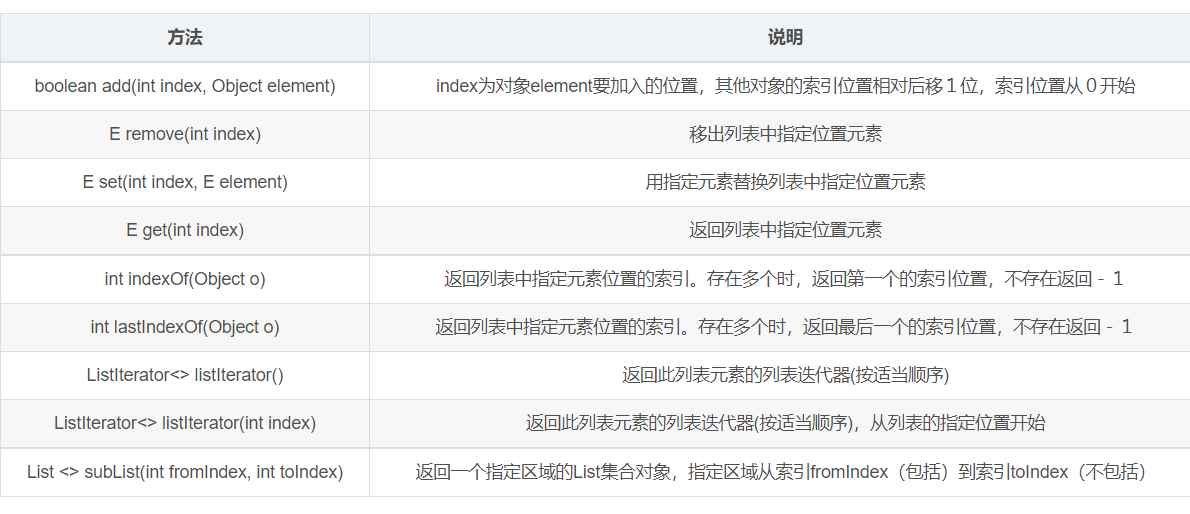
Iterator<String> it = list.iterator(); while (it.hasNext()) { System.out.println(it.next()); } arrayList.size() System.out.println("arrayList的指定区域为"+arrayList.subList(1,2));//返回列表中指返回一个指定区域的List集合对象[1,2)
LinkedList类的常用方法
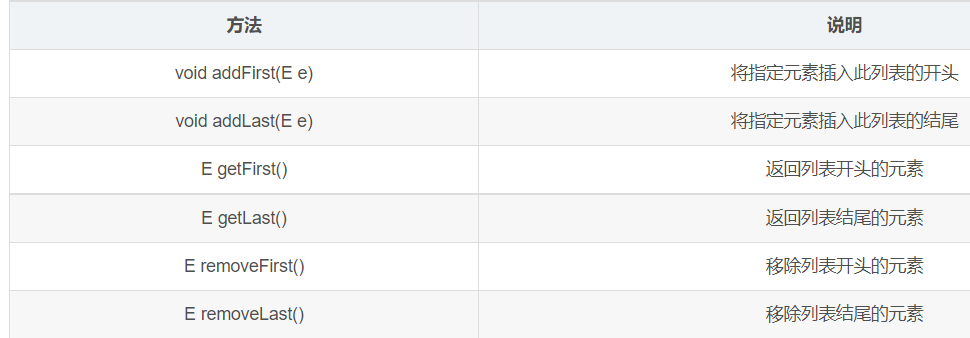
用上面方法必须 LinkedList<Integer> l = new LinkedList<>();
List<Integer> l = new LinkedList<>(); 会报错
static List<List> a = new ArrayList<List>(); static List b = new ArrayList<>(); public static void main(String[] args) { for (int i = 0; i < 3; i++) { b.add(i); } System.out.println("b" + b); a.add(b); System.out.println("a" + a); b.clear(); System.out.println("b clear: " + a); for (int i = 2; i < 6; i++) { b.add(i); } System.out.println("b" + b); a.add(b); System.out.println("a" + a); }
b[0, 1, 2]
a[[0, 1, 2]]
b clear: [[]]
b[2, 3, 4, 5]
a[[2, 3, 4, 5], [2, 3, 4, 5]]
public static void main(String[] args) { List<List<Integer>> a=new ArrayList<List<Integer>>(); for(int i=0;i<3:i++) { List<Integer> b=new ArrayList<Integer>(); for(int j=0;j<=i;j++) { b.add(j); } a.add(b); } System.out.println(a); }
[[0], [0, 1], [0, 1, 2]]
import java.util.concurrent.CountDownLatch; import java.util.concurrent.ExecutorService; import java.util.concurrent.Executors; import java.util.concurrent.Semaphore; import javax.swing.border.LineBorder; import java.util.*; public class Main { static class Node { int key, value; public Node(int key, int value) { this.key = key; this.value = value; } } public static void main(String[] args) { LinkedList<Node> list = new LinkedList<>(); list.add(new Node(1, 10)); list.add(new Node(2, 20)); list.add(new Node(3, 30)); System.out.println(list.size()); Iterator<Node> ite = list.iterator(); while (ite.hasNext()) { Node tmp = ite.next(); if (tmp.key == 2) { list.remove(tmp); } } Iterator<Node> itee = list.iterator(); while (itee.hasNext()) { Node tmp = itee.next(); System.out.println(tmp.key + " " + tmp.value); } } } // 操作系统的上下文切换 内存管理 // 一些容器的实现
3
1 10
3 30
Map
Map集合用于保存具有映射关系的数据,在Map集合中保存着两组值,一组值是key键,另一组值是value值。key和value之间存在一对一的关系,
通过指定的key键就能找到唯一的value值。Map中的key键不允许重复(key键唯一),value值可以重复。
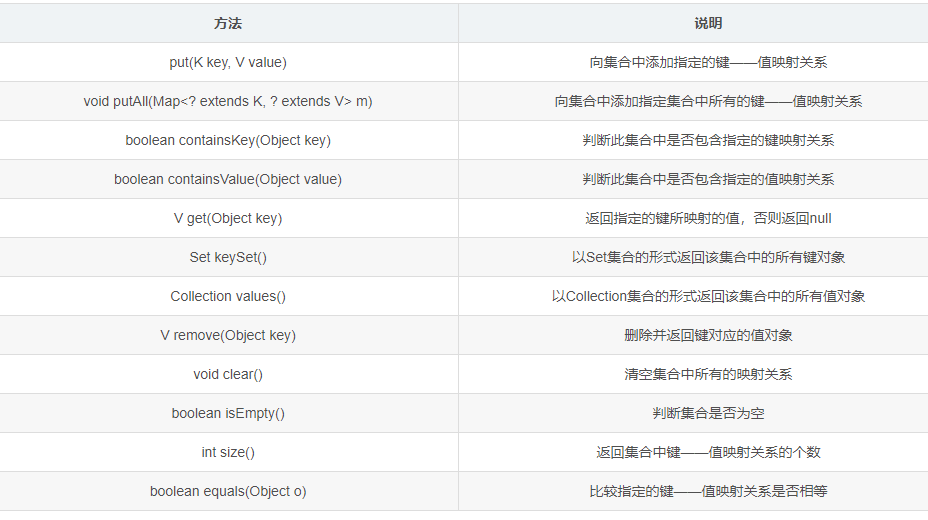
在JDK8之后,对map新增了getOrDefault()方法
Map.getOrDefault(key,默认值);
Map中会存储一一对应的key和value。
如果 在Map中存在key,则返回key所对应的的value。
如果 在Map中不存在key,则返回默认值。
Map map1 = new HashMap<>(); Map map2 = new HashMap<>(); Map map3 = new HashMap<>(); map1.put(1001, "bc"); map1.put(1002, "ab"); map1.put(null, null); map2.put(1003, "B"); map2.put(100, "C"); map3.put(100, "C"); map3.put(1003, "B"); System.out.println("map1: " + map1); System.out.println("map2: " + map2); map1.putAll(map2); System.out.println("map1: " + map1); // map1: {null=null, 1001=bc, 1002=ab} // map2: {100=C, 1003=B} // map1: {null=null, 100=C, 1001=bc, 1002=ab, 1003=B} // 如果把map2.put(1003, "B")改为map2.put(1001, "B"); // map1: {null=null, 1001=bc, 1002=ab} // map2: {100=C, 1001=B} // map1: {null=null, 100=C, 1001=B, 1002=ab},1001唯一,value值被覆盖 System.out.println("map1是否包含键对象null: " + map1.containsKey(null)); System.out.println("map1是否包含\"a\"值 :" + map1.containsValue("a")); System.out.println("map1的键1001的对象为 :" + map1.get(1001)); System.out.println("map1的键对象为 :" + map1.keySet()); System.out.println("map1的值对象为 :" + map1.values()); System.out.println("删除1003键对象后,map1的值对象为 :" + map1.remove(1003) + "," + map1); // map1是否包含键对象null: true // map1是否包含"a"值 :false // map1的键1001的对象为 :bc // map1的键对象为 :[null, 100, 1001, 1002, 1003] // map1的值对象为 :[null, C, bc, ab, B] // 删除1003键对象后,map1的值对象为 :B,{null=null, 100=C, 1001=bc, 1002=ab} map1.clear(); System.out.println("map1的值对象为 " + map1); System.out.println("map1是否为null" + map1.isEmpty()); System.out.println("map2的大小" + map2.size()); System.out.println("map2和map3是否是一个对象" + map2.equals(map3)); // map1的值对象为 {} // map1是否为nulltrue // map2的大小2 // map2和map3是否是一个对象true
HashMap类
HashMap实现了Map接口,因此HashMap有Map接口提供的所有常用方法。同HashSet类似,HashMap不能保证元素的顺序。
HashMap的底层实现采用了哈希表,JDK1.8之前,HashMap的底层是采用数组+链表的方法,即用链表处理哈希冲突。
HashMap允许有一个键为null,允许多个值为null
HashMap map = new HashMap(); map.put("asd", 1); map.put("2das", 2); map.put("3das", 3); map.put("4das", 4); map.put("4das", 5);// 存在相同的key时,后插入的会被覆盖 System.out.println(map);// 不能保证有序 System.out.println(map.containsKey(99));// for (Object o : map.keySet()) { System.out.println(o + "-->" + map.get(o)); }
{asd=1, 3das=3, 4das=5, 2das=2}
false
asd-->1
3das-->3
4das-->5
2das-->2
TreeMap类
TreeMap是Map接口的主要实现类,TreeMap存放的是有序数据,按照key进行排序。
TreeMap底层采用红黑树(红黑树的每个节点就是一个key-value对)对key-value进行排序。
import java.util.*; Student s1 = new Student("Allen", 20, 1); Student s2 = new Student("Allen", 20, 45); Student s3 = new Student("Catalina", 40, 2); Student s4 = new Student("Diana", 30, 0); // 无参的构造方法 TreeMap<Student, String> map = new TreeMap<>();// 对key 排序,不然没有意义 map.put(s2, "bb"); map.put(s1, "aa"); map.put(s4, "dd"); map.put(s3, "cc"); for (Object o : map.keySet()) { System.out.println(map.get(o) + "-->" + o); } } static class Student implements Comparable<Student> { // public class Student{ private String name; private int age; private int id; public Student() { } public Student(String name, int age, int id) { this.name = name; this.age = age; this.id = id; } public String getName() { return name; } public void setName(String name) { this.name = name; } public int getAge() { return age; } public void setAge(int age) { this.age = age; } public int getId() { return id; } public void setId(int id) { this.id = id; } @Override public String toString() { return "Student{" + "name='" + name + '\'' + ", age=" + age + ", id=" + id + '}'; } @Override public int compareTo(Student s1) { // int cmp = age - s1.age;//按age从小到大 // bb-->Student{name='Allen', age=10} // aa-->Student{name='Allen', age=20} // dd-->Student{name='Diana', age=30} // cc-->Student{name='Catalina', age=40} // int cmp = name.compareTo(s1.name); // cmp = cmp != 0 ? cmp : age - s1.age; // bb-->Student{name='Allen', age=10} // aa-->Student{name='Allen', age=20} // cc-->Student{name='Catalina', age=40} // dd-->Student{name='Diana', age=30} // int cmp = s1.name.compareTo(name); // cmp = cmp != 0 ? cmp : s1.age - age;// 先按name大到小,然后age大到小 // dd-->Student{name='Diana', age=30} // cc-->Student{name='Catalina', age=40} // aa-->Student{name='Allen', age=20} // bb-->Student{name='Allen', age=10} int cmp = name.compareTo(s1.name);//继续加入ID if (cmp != 0) { return cmp; } else { int cmp1 = age - s1.age; if (cmp1 != 0) { return cmp1; } else { return id - s1.id; } } // aa-->Student{name='Allen', age=20, id=1} // bb-->Student{name='Allen', age=20, id=45} // cc-->Student{name='Catalina', age=40, id=2} // dd-->Student{name='Diana', age=30, id=0} } } }
常用的接口方法
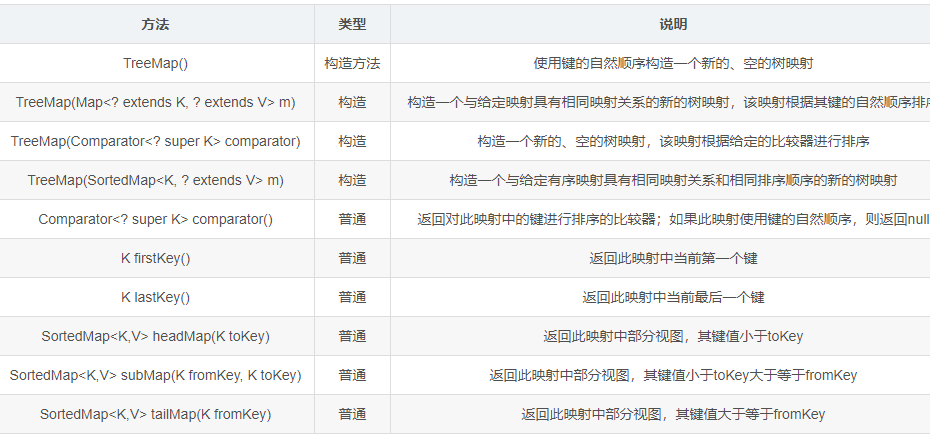
TreeMap treeMap = new TreeMap<>();//构造方法1 treeMap.put(10, "a"); treeMap.put(1, "a"); treeMap.put(9, null); treeMap.put(5, "c"); treeMap.put(3, null); System.out.println(treeMap); System.out.println("first key " + treeMap.firstKey()); System.out.println("last key " + treeMap.lastKey()); System.out.println(treeMap.headMap(3)); System.out.println(treeMap.subMap(3, 7)); System.out.println(treeMap.tailMap(5)); TreeMap treeMap1 = new TreeMap(treeMap);//构造方法2
System.out.println(treeMap1);
{1=a, 3=null, 5=c, 9=null, 10=a}
first key 1
last key 10
{1=a}
{3=null, 5=c}
{5=c, 9=null, 10=a}
{1=a, 3=null, 5=c, 9=null, 10=a}
TreeMap和HashMap性能比较
HashMap没有按照键值大小输出,如果需要对key-value进行插入、删除操作,优先使用HashMap;
TreeMap按照键值大小输出,,针对需要排序的Map,优先使用TreeMap。
HashTable是线程安全的类,很多方法都是用synchronized修饰,但同时因为加锁导致并发效率低下,单线程环境效率也十分低;
Map bug
import java.util.*; import javax.swing.plaf.synth.SynthSplitPaneUI; public class Main { public static void main(String[] args) throws Exception { Map<StringBuilder, Integer> map = new HashMap<>(); int nums[] = { 1, 7, 4, 0 }; StringBuilder s = new StringBuilder(); for (int x : nums) { s.append(x); } map.put(s, 15); for (Object o : map.keySet()) { System.out.println("yiyoude " + o + " " + map.get(o)); } System.out.println("........."); s.append("5"); map.put(new StringBuilder(s), 56); // StringBuilder s1 = new StringBuilder(s); // s1.append("5"); // map.put(s1, 56); for (Object o : map.keySet()) { System.out.println("yiyoude " + o + " " + map.get(o)); } } }
yiyoude 1740 15
.........
yiyoude 17405 56
yiyoude 17405 15
key重复
解决 import java.util.*; import javax.swing.plaf.synth.SynthSplitPaneUI; public class Main { public static void main(String[] args) throws Exception { Map<StringBuilder, Integer> map = new HashMap<>(); int nums[] = { 1, 7, 4, 0 }; StringBuilder s = new StringBuilder(); for (int x : nums) { s.append(x); } map.put(s, 15); for (Object o : map.keySet()) { System.out.println("yiyoude " + o + " " + map.get(o)); } System.out.println("........."); map.put(s, 56); StringBuilder s1 = new StringBuilder(s); s1.append("5"); map.put(s1, 56); for (Object o : map.keySet()) { System.out.println("yiyoude " + o + " " + map.get(o)); } } }
yiyoude 1740 15
.........
yiyoude 17405 56
yiyoude 1740 56
HashMap和Hashtable有什么区别?
- HashMap是Hashtable的轻量级实现,HashMap允许key和value为null,但最多允许一条记录的key为null.而HashTable不允许。
- HashTable中的方法是线程安全的,而HashMap不是。在多线程访问HashMap需要提供额外的同步机制。
- Hashtable使用Enumeration进行遍历,HashMap使用Iterator进行遍历。
Stack
栈是Vector的一个子类,它实现了一个标准的后进先出的栈。
Stack stack = new Stack(); System.out.println(stack.empty()); stack.push(1); stack.push("aj"); stack.push('A'); System.out.println(stack.search("aj"));// 从1开始 System.out.println(stack.peek());// 查看堆栈顶部的对象,但不从堆栈中移除它。 while (!stack.isEmpty()) { Object o = stack.pop();// 移除堆栈顶部的对象,并作为此函数的值返回该对象。 System.out.println(o); }
true
2
A
A
aj
1
输入两个整数序列,第一个序列表示栈的压入顺序,请判断第二个序列是否为该栈的弹出顺序。假设压入栈的所有数字均不相等。例如,序列 {1,2,3,4,5} 是某栈的压栈序列,序列 {4,5,3,2,1} 是该压栈序列对应的一个弹出序列,但 {4,3,5,1,2} 就不可能是该压栈序列的弹出序列。
示例 1:
输入:pushed = [1,2,3,4,5], popped = [4,5,3,2,1] 输出:true 解释:我们可以按以下顺序执行: push(1), push(2), push(3), push(4), pop() -> 4, push(5), pop() -> 5, pop() -> 3, pop() -> 2, pop() -> 1
class Solution { public boolean validateStackSequences(int[] pushed, int[] popped) { Stack<Integer>sta =new Stack(); int i =0; for(int num:pushed){ sta.push(num); while(!sta.isEmpty()&&sta.peek()==popped[i]) { sta.pop(); i++; } } return sta.isEmpty(); } }
DFS 指定入栈顺序输出所有出栈顺序
import java.util.*; public class Main { static int cnt = 0; static char in[] = { '1', '2', '3', '4' }; static String tmp; static void dfs(int num, Stack sta, String sout) {// num:当前压入栈的数目 if (num == in.length && sta.isEmpty()) { System.out.println(sout); cnt++; return; } else { Stack sta1 = (Stack) sta.clone(); Stack sta2 = (Stack) sta.clone();//要新建,因为对象传的是地址 if (num < in.length) { sta1.push(in[num]); dfs(num + 1, sta1, sout); } if (!sta2.isEmpty()) {//必须if tmp = sout + sta2.pop(); dfs(num, sta2, tmp); } } } public static void main(String[] args) { dfs(0, new Stack(), ""); System.out.println(cnt); } }
Queue
Queue接口是一个先入先出(FIFO)的数据结构,继承Collection接口,LinkedList(双向链表)实现了List和Deque接口。
Queue<String> queue = new LinkedList<String>(); queue.offer("a"); queue.offer("b"); queue.offer("c"); queue.offer("d"); // offer,add 区别: // 一些队列有大小限制,因此如果想在一个满的队列中加入一个新项,多出的项就会被拒绝。 // 这时新的 offer 方法就可以起作用了。它不是对调用 add() 方法抛出一个 unchecked 异常,而只是得到由 offer() 返回的 // false。 for (String x : queue) { System.out.println(x); } System.out.println("____"); System.out.println(queue.poll());// 返回第一个元素,并在队列中删除 System.out.println("____"); // poll,remove 区别: // remove() 和 poll() 方法都是从队列中删除第一个元素。 // remove() 的行为与 Collection 接口的版本相似, 但是新的 poll() 方法在用空集合调用时不是抛出异常,只是返回 // null。因此新的方法更适合容易出现异常条件的情况。 for (String x : queue) { System.out.println(x); } System.out.println("____"); System.out.println(queue.peek());// 返回第一个元素 System.out.println("____"); // peek,element区别: // element() 和 peek() 用于在队列的头部查询元素。与 remove() 方法类似,在队列为空时, element() 抛出一个异常,而 // peek() 返回 null for (String x : queue) { System.out.println(x); }
a
b
c
d
____
a
____
b
c
d
____
b
____
b
c
d
PriorityQueue
class IntegerComparator implements Comparator<Integer> { @Override public int compare(Integer s1, Integer s2) { return s2 - s1; } } Queue<Integer> queue = new PriorityQueue<>();//默认升序 queue.offer(2); queue.offer(1); queue.offer(6); queue.offer(0); queue.offer(9); while (!queue.isEmpty()) { System.out.println(queue.poll() + " "); } System.out.println("______"); Queue<Integer> queu = new PriorityQueue<>(new IntegerComparator());//逆序 queu.offer(2); queu.offer(1); queu.offer(6); queu.offer(0); queu.offer(9); while (!queu.isEmpty()) { System.out.println(queu.poll() + " "); }
0
1
2
6
9
______
9
6
2
1
0
class Node { int x, y; public Node(int x, int y) { this.x = x; this.y = y; } } public class RongQi { static int[] nums = { 1, 2, 2, 3, 4, 4, 3, 5, 5, 5 }; static class Icompator implements Comparator<Node> { @Override public int compare(Node s1, Node s2) { // 操作 if (s1.x == s2.x) { return s1.y - s2.y; } return s1.x - s2.x; } } public static void main(String[] args) { Queue<Node> q = new PriorityQueue<>(new Icompator()); Node n1 = new Node(1, 2); Node n2 = new Node(2, 5); Node n3 = new Node(2, 3); q.offer(n1); q.offer(n2); q.offer(n3); Node n; while (!q.isEmpty()) { n = q.poll(); System.out.println("x: " + n.x + " y: " + n.y); }
x: 1 y: 2
x: 2 y: 3
x: 2 y: 5
如何得到一个数据流中的中位数?如果从数据流中读出奇数个数值,那么中位数就是所有数值排序之后位于中间的数值。如果从数据流中读出偶数个数值,那么中位数就是所有数值排序之后中间两个数的平均值。
例如,
[2,3,4] 的中位数是 3
[2,3] 的中位数是 (2 + 3) / 2 = 2.5
设计一个支持以下两种操作的数据结构:
- void addNum(int num) - 从数据流中添加一个整数到数据结构中。
- double findMedian() - 返回目前所有元素的中位数。
class MedianFinder { Queue<Integer>minheap,maxheap; /** initialize your data structure here. */ public MedianFinder() { minheap =new PriorityQueue<Integer>();//维护大的一半 maxheap =new PriorityQueue<Integer>((x,y)->(y-x));//(y-x)维护小的一半 } public void addNum(int num) { //先往minheap 装,保证元素个数为奇数时中位数为minheap.peek(); 也就是minheap中元素数目始终多一个 //装时注意:需要向minheap装, 先装入maxheap,将maxheap的顶部元素弹出并装入minheap.这样可保证minheap始终维护大的一半 //需要向maxheap装,类似 if(minheap.size()!=maxheap.size()){ minheap.offer(num); maxheap.offer(minheap.poll()); } else{ maxheap.offer(num); minheap.offer(maxheap.poll()); } } public double findMedian() { return maxheap.size()==minheap.size()? (minheap.peek()+maxheap.peek())*0.5:minheap.peek(); } } /** * Your MedianFinder object will be instantiated and called as such: * MedianFinder obj = new MedianFinder(); * obj.addNum(num); * double param_2 = obj.findMedian(); */
时间复杂度 :优先队列的弹出,压入 O(logn) 中位数查找 O(1)
空间复杂度: O(n)
双端队列 Deque
Deque<Integer> que = new LinkedList(); que.offerFirst(1); que.offerLast(2); que.offerFirst(3); que.offerLast(4); for (int x : que) { System.out.println(x);// 3 1 2 4 } que.pollFirst(); for (int x : que) { System.out.println(x);// 1 2 4 } que.pollLast(); for (int x : que) { System.out.println(x);// 1 2 } System.out.println(que.peekFirst());// 1 System.out.println(que.peekLast());// 2
Set
List集合按照对象的插入顺序保存对象,Set集合的对象不按照顺序保存对象,可以说是不完全无序状态。
Set集合中的对象没有按照特定的方式排序,仅仅简单地将对象加入其中,但是集合中不能存放重复对象。由于Set接口实现了Collection接口,所以Set接口有Collection接口提供的所有常用方法
HashSet类
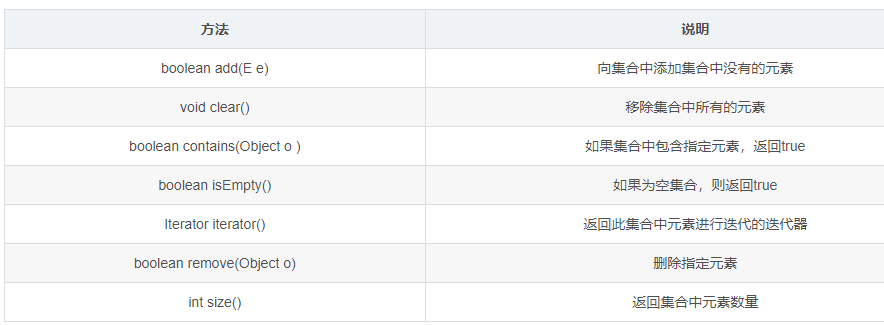
可以add null
Set集合中不允许重复的元素存在,当向集合中插入对象时,如何判别在集合中是否已经存在该对象?
查看源码可知:当向HashSet对象添加新对象时,Java系统先调用对象的hashCode()方法来获取该对象的哈希码,如何根据哈希码找到对应的存储区域。如果该存储区域已经有了对象,则调用equals()方法与新元素进行比较,相同就不保存,
如果不同的话,就会重新散列到其他位置。这样我们就大大减少了 equals 的次数,相应就大大提高了执行速度。
针对用户自行定义的对象,需要重写hashCode()和equals()方法才能避免重复添加对象,保证程序的正常运行。
TreeSet类
TreeSet集合中的元素处于排序状态,主要按照红黑树的数据结构来存储对象。TreeSet提供了一些额外的方法。
Java中线程安全的基本数据结构有哪些
线程安全 :一段操纵共享数据的代码能够保证在同一时间内被多个线程执行而仍然保持其正确性的,就被称为是线程安全的。
HashTable: 哈希表的线程安全版,效率低
HashTable使用synchronized来修饰方法函数来保证线程安全,但是在多线程运行环境下效率表现非常低下。
因为当一个线程访问HashTable的同步方法时,其他线程也访问同步方法就会出现阻塞状态。
比如当一个线程在添加数据时候,另外一个线程即使执行获取其他数据的操作也必须被阻塞,大大降低了程序的运行效率。
ConcurrentHashMap:哈希表的线程安全版,效率高,用于替代HashTable
ConcurrentHashMap是HashMap的线程安全版。
ConcurrentHashMap允许多个修改操作并发运行,其原因在于使用了锁分段技术:首先讲Map存放的数据分成一段一段的存储方式,然后给每一段数据分配一把锁,
当一个线程占用锁访问其中一个段的数据时,其他段的数据也能被其他线程访问。这样就保证了每一把锁只是用于锁住一部分数据,那么当多线程访问Map里的不同数据段的数据时,线程间就不会存在锁竞争,从而可以有效提高并发访问效率。
上述的处理机制明显区别于HashTable是给整体数据分配了一把锁的处理方法。为此,在多线程环境下,常用ConcurrentHashMap在需要保证数据安全的场景中去替换HashMap,而不会去使用HashTable,同时在最新版的JDK中已经推荐废弃使用HashTable。
Vector:线程安全版Arraylist
利用synchronized同步锁机制进行实现,其实现方式与HashTable类似
Stack:线程安全版栈
BlockingQueue及其子类:线程安全版队列
https://www.jianshu.com/p/b1408e3e3bb4
StringBuffer
synchronized修饰实现其线程安全特性
ArrayList、Vector和LinkedList有什么共同点与区别?
- ArrayList、Vector和LinkedList都是可伸缩的数组,即可以动态改变长度的数组。
- ArrayList和Vector都是基于存储元素的Object[] array来实现的,它们会在内存中开辟一块连续的空间来存储,支持下标、索引访问。但在涉及插入元素时可能需要移动容器中的元素,插入效率较低。当存储元素超过容器的初始化容量大小,ArrayList与Vector均会进行扩容。
- Vector是线程安全的,其大部分方法是直接或间接同步的。ArrayList不是线程安全的,其方法不具有同步性质。LinkedList也不是线程安全的。
- LinkedList采用双向链表实现,对数据索引需要从头开始遍历,因此随机访问效率较低,但在插入元素的时候不需要对数据进行移动,插入效率较高。